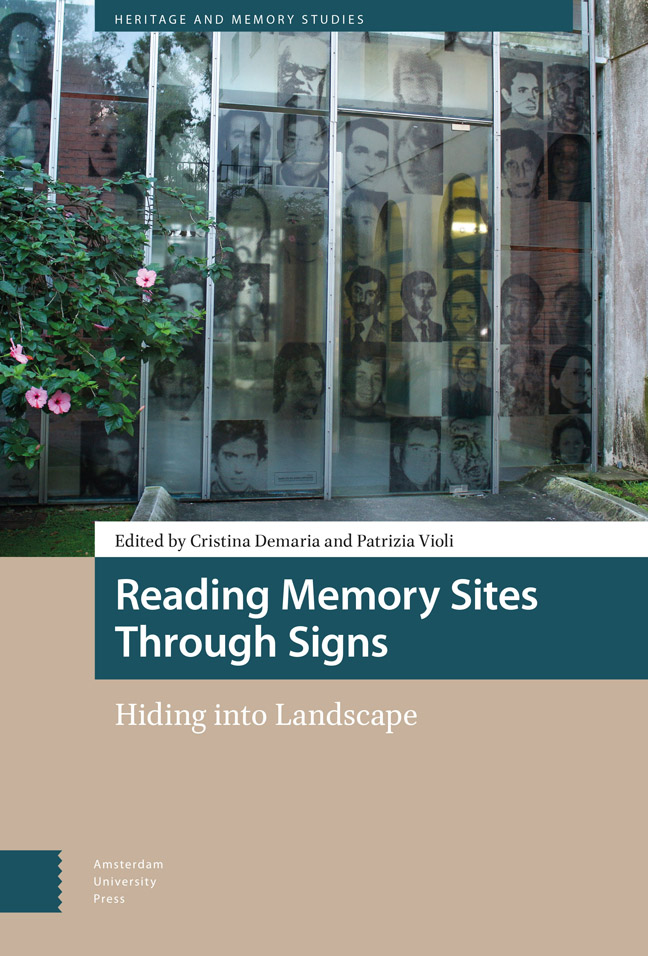Book contents
- Frontmatter
- Contents
- List of Illustrations
- For a Semiotics of Spaces of Memories: Practices of Enunciation and Narratives from Monuments to Global Landscapes of Inheritance
- 1 Stories that Shape Spatialities: Lieu and Milieu de Mémoire through the Lens of Narrativity
- 2 Interpretation and Use of Memory: How Practices Can Change the Meanings of Monuments
- 3 Uncomfortable Memories of Fascist Italy: The Case of Bigio of Brescia
- 4 What Does Fascist Architecture Still Have to Tell Us?: Preservation of Contested Heritage as a Strategy of Re-Enunciation and ‘Voice Remodulation’
- 5 Berlin, the Jewish Museum and the Holocaust Memorial
- 6 Making Space for Memory: Collective Enunciation in the Provincial Memory Archive of Córdoba, Argentina
- 7 Ruins of War: The Green Sea and the Mysterious Island
- 8 Turning Spaces of Memory into Memoryscapes: Cinema as Counter-Monument in Jonathan Perel's El Predio and Tabula Rasa
- 9 Voices from the Past: Memories in a Digital Space: The Case of AppRecuerdos in Santiago, Chile
- 10 500,000 Dirhams in Scandinavia, from Mobile Silver to Land Rent: A Semiotic Analysis
- Index
- Index of Names
10 - 500,000 Dirhams in Scandinavia, from Mobile Silver to Land Rent: A Semiotic Analysis
Published online by Cambridge University Press: 17 February 2024
- Frontmatter
- Contents
- List of Illustrations
- For a Semiotics of Spaces of Memories: Practices of Enunciation and Narratives from Monuments to Global Landscapes of Inheritance
- 1 Stories that Shape Spatialities: Lieu and Milieu de Mémoire through the Lens of Narrativity
- 2 Interpretation and Use of Memory: How Practices Can Change the Meanings of Monuments
- 3 Uncomfortable Memories of Fascist Italy: The Case of Bigio of Brescia
- 4 What Does Fascist Architecture Still Have to Tell Us?: Preservation of Contested Heritage as a Strategy of Re-Enunciation and ‘Voice Remodulation’
- 5 Berlin, the Jewish Museum and the Holocaust Memorial
- 6 Making Space for Memory: Collective Enunciation in the Provincial Memory Archive of Córdoba, Argentina
- 7 Ruins of War: The Green Sea and the Mysterious Island
- 8 Turning Spaces of Memory into Memoryscapes: Cinema as Counter-Monument in Jonathan Perel's El Predio and Tabula Rasa
- 9 Voices from the Past: Memories in a Digital Space: The Case of AppRecuerdos in Santiago, Chile
- 10 500,000 Dirhams in Scandinavia, from Mobile Silver to Land Rent: A Semiotic Analysis
- Index
- Index of Names
Summary
Abstract
The absence of written chronicles in Scandinavia during the period in which Islamic silver dirhams were brought from afar and hoarded in pits, necessitates the interpretation of non-verbal data (caches, emission dates of coins, cache distribution in space) and the restitution of actions (maritime and river travel, economic exchange) that produced such results. The interpretation process also needs the consideration of other caches containing precious objects and written sources from the East and the West. The data give us back the of a Scandinavian society in transformation. This chapter presents this study in three phases: physical space (from the Baltic to Baghdad and Tashkent), economic space (predation and/or exchange) and social space (differentiation of society according to collective actors defined by action).
Keywords: Scandinavia; Silver; Dirhams; Dar al-Islam; Frankish Kingdoms; Expeditionary Society.
Archaeological Facts Worthy of Attention
During my study of Umayyad epigraphic coins (Hammad 2018), I was stunned by the discovery that Scandinavian museums kept more silver dirhams, minted in Dar al-Islam, in their vaults than all the countries that minted them in historical times. There are almost five hundred thousand such coins. They were dug out of agricultural lands in the nineteenth century, when technical progress produced ploughshares that could reach new depths. More recent discoveries, made possible by metal detectors, often reveal hoards shattered by the accidental passage of ploughs. The hoard of Stora Velinge, dug up in 1936 on the island of Gotland (Sweden), contained 2,674 dirhams and a silver arm ring (Figure 10.1), with a total weight of eight kilograms; the Spillings hoard (found in 1999) contained 67 kilograms of silver made up of 14,200 dirhams and various ingots and jewellery. 350 dirham hoards have been recorded on Gotland alone, an island located in the Baltic Sea 80 kilometres off the Swedish coast. The coins were first credited to have been brought there by the famed Viking plunderers. But the continued discovery of dirham hoards scattered around the Baltic Sea, along the rivers flowing north into Baltic, or along rivers flowing south into the Black and Caspian Seas, needed another interpretation, that is, the existence, between the eighth and eleventh centuries, of regular commercial routes between the shores of the Baltic and Baghdad, Samarqand and Al-Shash (Tashkent).
These facts call for an explanation.
- Type
- Chapter
- Information
- Reading Memory Sites through SignsHiding into Landscape, pp. 255 - 314Publisher: Amsterdam University PressPrint publication year: 2023



